Basal cell carcinoma (patient information)
|
Basal cell carcinoma |
|
Basal cell carcinoma On the Web |
|---|
For the WikiDoc page for this topic, click here
| Basal cell carcinoma | |
| ICD-9 | 173 |
|---|---|
| ICD-O: | 8090/3-8093/3 |
| OMIM | 605462 |
| DiseasesDB | 1264 |
| MeSH | D002280 |
Editor-In-Chief: C. Michael Gibson, M.S., M.D. [1]; Associate Editor(s)-In-Chief: Laura Linnemeier; Jinhui Wu, M.D., Maneesha Nandimandalam, M.B.B.S.[2]
Overview
- Skin cancer is the most common type of cancer in this country. About one million Americans develop skin cancer each year. Skin cancer begins in cells, the building blocks that make up the skin. Normally, skin cells grow and divide to form new cells. Every day skin cells grow old and die, and new cells take their place. Sometimes, this orderly process goes wrong. New cells form when the skin does not need them, and old cells do not die when they should. These extra cells can form a mass of tissue called a growth or tumor. These tumors can be either benign or malignant.
- The two most common types of skin cancer are basal cell cancer and squamous cell cancer. These cancers usually form on the head, face, neck, hands, and arms. These areas are exposed to the sun, but skin cancer can occur anywhere. Basal cell carcinoma is skin cancer that forms in basal cells (small, round cells in the base of the outer layer of skin). Basal cell skin cancer grows slowly. It usually occurs on areas of the skin that have been in the sun and is most common on the face. Basal cell cancer rarely spreads to other parts of the body.
What are the symptoms of Basal cell carcinoma?
A change on the skin is the most common sign of skin cancer. This may be a new growth, a sore that doesn't heal, or a change in an old growth. Sometimes skin cancer is painful, but usually it is not. Not all skin cancers look the same. Skin changes to watch for:
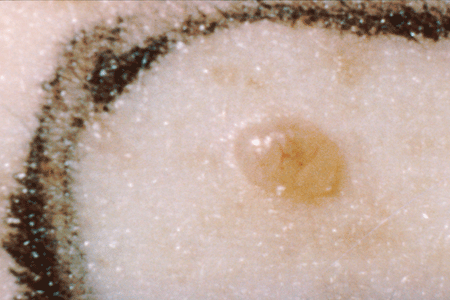
- Firm, red lump
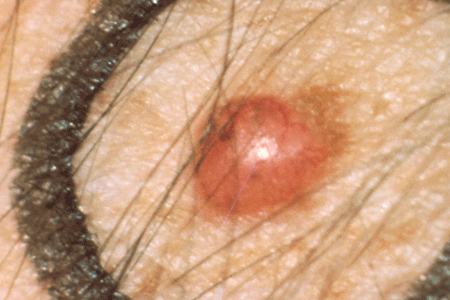
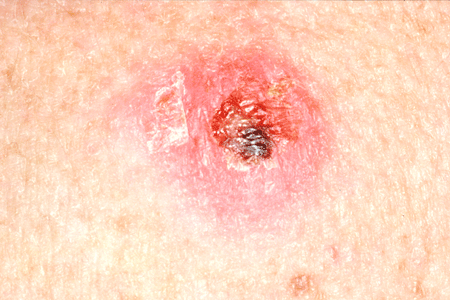
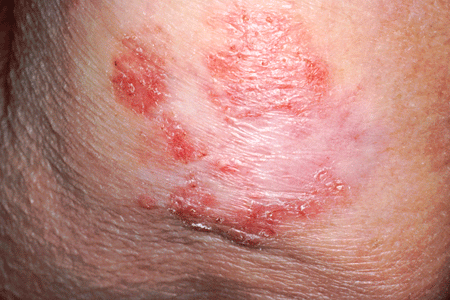
- Red or brown patch that is rough and scaly
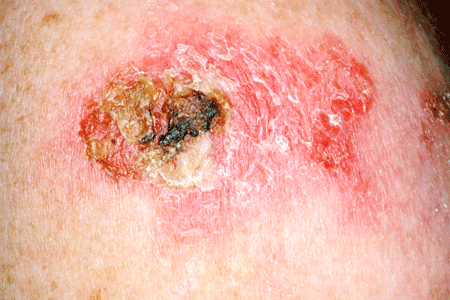
Who is at highest risk?
Doctors cannot explain why one person develops skin cancer and another does not, but we do know that skin cancer is not contagious. You cannot "catch" it from another person. However, research has shown that people with certain risk factors are more likely than others to develop skin cancer. The following are risk factors for skin cancer:
- Ultraviolet (UV) Radiation
UV radiation comes from the sun, sunlamps, tanning beds, or tanning booths. A person's risk of skin cancer is related to lifetime exposure to UV radiation. Most skin cancer appears after age 50, but the sun damages the skin from an early age. UV radiation affects everyone. But people who have fair skin that freckles or burns easily are at greater risk. These people often also have red or blond hair and light-colored eyes. But even people who tan can get skin cancer. People who live in areas that get high levels of UV radiation have a higher risk of skin cancer. In the United States, areas in the south (such as Texas and Florida) get more UV radiation than areas in the north (such as Minnesota). Also, people who live in the mountains get high levels of UV radiation. UV radiation is present even in cold weather or on a cloudy day.
- Scars or burns on the skin
- Infection with certain human papillomaviruses (HPV)
- Exposure to arsenic at work
- Chronic skin inflammation or skin ulcers
- Diseases that make the skin sensitive to the sun, such as xeroderma pigmentosum, albinism, and basal cell nevus syndrome
- Radiation therapy
- Medical conditions or drugs that suppress the immune system
- Personal history of one or more skin cancers
- Family history of skin cancer
- Actinic keratosis
Actinic keratosis is a type of flat, scaly growth on the skin. It is most often found on areas exposed to the sun, especially the face and the backs of the hands. The growths may appear as rough red or brown patches on the skin. They may also appear as cracking or peeling of the lower lip that does not heal. Without treatment, a small number of these scaly growths may turn into squamous cell cancer.
- Bowen's disease
Bowen's disease is a type of scaly or thickened patch on the skin. It may turn into squamous cell skin cancer.
When to seek urgent medical care?
If the biopsy shows that you have cancer, your doctor needs to know the extent (stage) of the disease. The stage is based on:
- The size of the growth
- How deeply it has grown beneath the top layer of skin
- Whether it has spread to nearby lymph nodes or to other parts of the body
The stages of skin cancer range from Stage 0 (when the cancer involves only the top layer of skin) to Stage IV (when the cancer has spread to other parts of the body).
Diagnosis
A doctor will perform a biopsy to determine whether any skin abnormality is, in fact, skin cancer. The doctor removes all or part of the area that does not look normal, the sample goes to a laboratory, and a pathologist checks the sample under a microscope.There are four common types of skin biopsies:
- Punch biopsy: The doctor uses a sharp, hollow tool to remove a circle of tissue from the abnormal area.
- Incisional biopsy: The doctor uses a scalpel to remove part of the growth.
- Excisional biopsy: The doctor uses a scalpel to remove the entire growth and some tissue around it.
- Shave biopsy: The doctor uses a thin, sharp blade to shave off the abnormal growth.
Most biopsies are performed with local anesthesia.
Treatment options
Sometimes all of the cancer is removed during the biopsy. In such cases, no more treatment is needed. If you do need more treatment, your doctor will describe your options. Treatment for skin cancer depends on the type and stage of the disease, the size and place of the growth, and your general health and medical history. In most cases, the aim of treatment is to remove or destroy the cancer completely. Surgery is the usual treatment for people with skin cancer. Surgery nearly always leaves some type of scar. The size and color of the scar depend on the size of the cancer, the type of surgery, and how your skin heals.
Surgery
- Excisional skin surgery is a common treatment to remove skin cancer. After numbing the area, the surgeon removes the growth with a scalpel. The surgeon also removes a border of skin around the growth.
- Mohs surgery is often used for skin cancer. A surgeon shaves away thin layers of the growth and continues to shave away tissue until no cancer cells can be seen under the microscope. In this way, the surgeon can remove all the cancer and only a small bit of healthy tissue.
- Electrodesiccation and curettage is often used to remove small basal cell skin cancers. The cancer is removed with a sharp tool shaped like a spoon called a curette. An electric current is sent into the treated area to control bleeding and kill any cancer cells that may be left. Electrodesiccation and curettage is usually a fast and simple procedure.
- Cryosurgery is often used for people who are not able to have other types of surgery. It uses the extreme cold of liquid nitrogen to treat early stage or very thin skin cancer. The doctor applies liquid nitrogen directly to the skin growth. This treatment may cause swelling. It also may damage nerves, which can cause a loss of feeling in the damaged area.
- Laser surgery uses a narrow beam of light to remove or destroy cancer cells. It is most often used for growths that are on the outer layer of skin only.
In some cases, the doctor may suggest topical chemotherapy, photodynamic therapy, or radiation therapy.
Topical Chemotherapy
Chemotherapy uses anticancer drugs to kill skin cancer cells. When a drug is put directly on the skin, the treatment is topical chemotherapy. It is most often used when the skin cancer is too large for surgery. It is also used when the doctor keeps finding new cancers. Most often, the drug comes in a cream or lotion. It is usually applied to the skin one or two times a day for several weeks. These drugs may cause your skin to turn red or swell. It also may itch, hurt, ooze, or develop a rash. It may be sore or sensitive to the sun. These skin changes usually go away after treatment is over. Topical chemotherapy usually does not leave a scar.
Photodynamic Therapy
Photodynamic therapy (PDT) uses a chemical along with a special light source, such as a laser light, to kill cancer cells. The chemical is a photosensitizing agent. A cream is applied to the skin or the chemical is injected. It stays in cancer cells longer than in normal cells. Several hours or days later, the special light is focused on the growth. The chemical becomes active and destroys nearby cancer cells. PDT is used to treat cancer on or very near the surface of the skin. The side effects of PDT are usually not serious. PDT may cause burning or stinging pain. It also may cause burns, swelling, or redness. It may scar healthy tissue near the growth. If you have PDT, you will need to avoid direct sunlight and bright indoor light for at least 6 weeks after treatment.
Radiation Therapy
Radiation therapy (also called radiotherapy) uses high-energy rays to kill cancer cells. The rays come from a large machine outside the body. They affect cells only in the treated area. Radiation is not a common treatment for skin cancer. But it may be used for skin cancer in areas where surgery could be difficult or leave a bad scar. You may have this treatment if you have a growth on your eyelid, ear, or nose. It also may be used if the cancer comes back after surgery to remove it. Side effects depend mainly on the dose of radiation and the part of your body that is treated. During treatment your skin in the treated area may become red, dry, and tender.
Prevention
Avoid UV Radiaion
The best way to prevent skin cancer is to protect yourself from the sun. Also, protect children from an early age. Doctors suggest that people of all ages limit their time in the sun and avoid other sources of UV radiation. It is best to stay out of the midday sun (from mid-morning to late afternoon) whenever you can. You also should protect yourself from UV radiation reflected by sand, water, snow, and ice. UV radiation can go through light clothing, windshields, windows, and clouds. Wear long sleeves and long pants of tightly woven fabrics, a hat with a wide brim, and sunglasses that absorb UV. Use sunscreen lotions. Sunscreen may help prevent skin cancer, especially broad-spectrum sunscreen (to filter UVB and UVA rays) with a sun protection factor (SPF) of at least 15. But you still need to avoid the sun and wear clothing to protect your skin. Stay away from sunlamps and tanning booths.
Do a Skin Self-Exam
The best time to do this exam is after a shower or bath. You should check your skin in a room with plenty of light. You should use a full-length mirror and a hand-held mirror. It's best to begin by learning where your birthmarks, moles, and other marks are and their usual look and feel.
Check for anything new.
- New mole (that looks different from your other moles)
- New red or darker color flaky patch that may be a little raised
- New flesh-colored firm bump
- Change in the size, shape, color, or feel of a mole
- Sore that does not heal
Check yourself from head to toe. Don't forget to check your back, scalp, genital area, and between your buttocks.
- Look at your face, neck, ears, and scalp. You may want to use a comb or a blow dryer to move your hair so that you can see better. You also may want to have a relative or friend check through your hair. It may be hard to check your scalp by yourself.
- Look at the front and back of your body in the mirror. Then, raise your arms and look at your left and right sides.
- Bend your elbows. Look carefully at your fingernails, palms, forearms (including the undersides), and upper arms.
- Examine the back, front, and sides of your legs. Also look around your genital area and between your buttocks.
- Sit and closely examine your feet, including your toenails, your soles, and the spaces between your toes.
By checking your skin regularly, you will learn what is normal for you. It may be helpful to record the dates of your skin exams and to write notes about the way your skin looks. If your doctor has taken photos of your skin, you can compare your skin to the photos to help check for changes. If you find anything unusual, see your doctor.
Where to find medical care for Basal cell carcinoma?
Directions to Hospitals Treating Basal cell carcinoma
What to expect (Outlook/Prognosis)?
Skin cancer has a better prognosis, or outcome, than most other types of cancer.
Follow-up care after treatment for skin cancer is important. Your doctor will monitor your recovery and check for new skin cancer. New skin cancers are more common than having a treated skin cancer spread. Regular checkups help ensure that any changes in your health are noted and treated if needed. Between scheduled visits, you should check your skin regularly. You should contact the doctor if you notice anything unusual. It also is important to follow your doctor's advice about how to reduce your risk of developing skin cancer again.
Source
The National Cancer Institute, http://www.cancer.gov/cancertopics/wyntk/skin/page1 Template:WH Template:WS